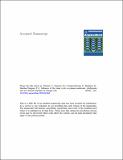Please use this identifier to cite or link to this item:
http://hdl.handle.net/10261/44989Share/Export:
 SHARE SHARE
 CORE
BASE CORE
BASE
|
|
| Visualizar otros formatos: MARC | Dublin Core | RDF | ORE | MODS | METS | DIDL | DATACITE | |

| Title: | Influence of the lunar cycle on plasma melatonin, vitellogenin and sex steroids rhythms in Senegal sole, Solea senegalensis |
Authors: | Oliveira, Catarina R.; Duncan, Neil; Pousão-Ferreira, P.; Mañanós, Evaristo L. CSIC ORCID; Sánchez-Vázquez, F. J. | Keywords: | Lunar rhythms Melatonin Sex steroids Vitellogenin Solea |
Issue Date: | Aug-2010 | Publisher: | Elsevier | Citation: | Aquaculture 306(1-4): 343-347 (2010) | Abstract: | The effect of the moon light cycle on plasma melatonin rhythms was examined in Senegal sole (Solea senegalensis) exposed to natural outdoor or artificial indoor lighting conditions. Furthermore, in a second experiment, the effect of the lunar cycle on vitellogenin and sex steroids (Testosterone, T; Estradiol, E2; 11-ketotestosterone, 11kt) was studied using mature individuals during reproductive season. In the first experiment, during full moon, plasma melatonin peaked at night in covered tanks (deprived of night illumination) from both outdoor (133.2 ± 12.8 pg ml-1) and indoor (190.6 ± 41.5 pg ml-1) groups. However, for fish in the open tanks, exposed to approximately 0.3 lux of illumination, nocturnal plasma melatonin was significantly reduced (p<0.05), approaching to mid-light (ML) values, (79.6 ± 7.1 and 81.8 ± 14.0 pg ml-1, for outdoor and indoor groups, respectively). During new moon a similar pattern was observed in outdoor group: fish in the covered tank showed higher melatonin values than those in the open tank, which were exposed to the near undetectable night illumination. In the second experiment, plasma sex steroid concentrations were significantly higher during the full moon compared to the new moon. In the case of females, E2 concentration reduced from 2.4 ± 0.6 to 0.4 ± 0.1 ng ml-1 between full and new moon samplings, while T decreased from 0.3 ± 0.0 to 0.2 ± 0.0 ng ml-1. Vitellogenin, however, did not show such differences between moon phases. In males, 11kt exhibited a plasma concentration of 14.3 ± 2.1 ng ml-1 during full moon and 4.7 ± 0.7 ng ml-1 during new moon while T values were 2.6 ± 0.4 and 1.0 ± 0.1 ng ml-1 for full and new moon, respectively. In conclusion, these findings pointed out the high sensitivity to moon light of the Senegal sole, which could be using the melatonin signalling to synchronize their reproduction rhythms to the lunar cycle. | Description: | 24 p., il., y bibliografía | Publisher version (URL): | http://dx.doi.org/10.1016/j.aquaculture.2010.05.003 | URI: | http://hdl.handle.net/10261/44989 | DOI: | 10.1016/j.aquaculture.2010.05.003 | ISSN: | 0044-8486 |
| Appears in Collections: | (IATS) Artículos |
Files in This Item:
| File | Description | Size | Format | |
|---|---|---|---|---|
| Oliveira etal 2010 AQUA in press.pdf | 457,91 kB | Adobe PDF |  View/Open |
CORE Recommender
SCOPUSTM
Citations
24
checked on Apr 18, 2024
WEB OF SCIENCETM
Citations
22
checked on Feb 25, 2024
Page view(s)
388
checked on Apr 19, 2024
Download(s)
391
checked on Apr 19, 2024
Google ScholarTM
Check
Altmetric
Altmetric
WARNING: Items in Digital.CSIC are protected by copyright, with all rights reserved, unless otherwise indicated.
